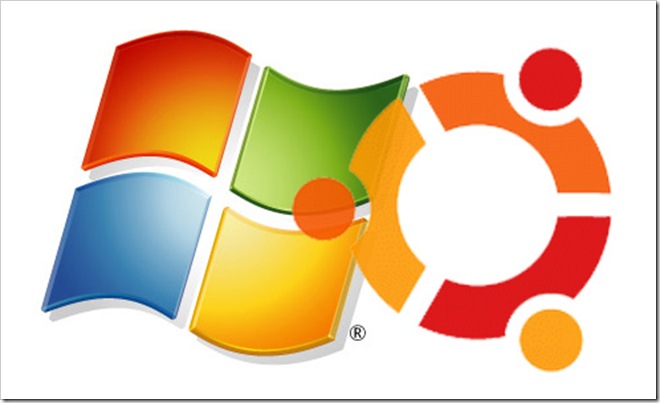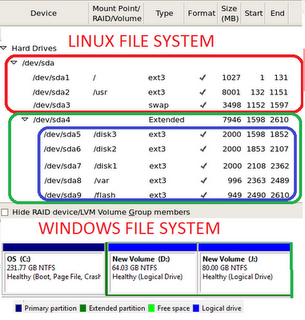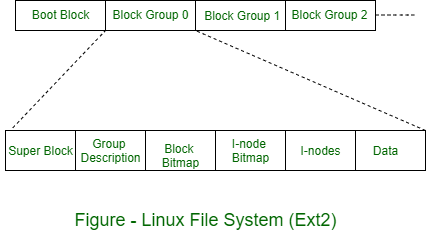
Windows uses FAT and NTFS as file systems, while Linux uses a variety of file systems.
Unlike Windows, Linux is bootable from a network drive.
In contrast to Windows, everything is either a file or a process in Linux. Please see one of my earlier post What “Everything Is a File” Means on Linux.
Linux has two kinds of major partitions called data partitions and swap partitions. Because of the existence of swap partitions, you never run out of memory in Linux (like in windows).
In terms of recovery tools, only a limited number of tools can be used on Windows, while there is a large number of UNIX based recovery tools available for Linux file systems.
From the author Nigel McFarlane:
Both Windows and Linux organize disk-based files into a hierarchy of directories. Such directories are usually called “folders” when viewed in a GUI. One whole hierarchy is called a “file system” on both platforms. The architecture of Windows and Linux file systems is similar in some points, but diverges greatly when tools are considered. Here’s a quick comparison.
On hardware derived from Intel or IBM PCs, both Windows and Linux use the Master Block Record/ Master Boot Record (MBR). That is the bit of disk used to boot the operating system and to state whether the disk is partitioned or not. On both Windows and Linux, it is common to have at most one file system per partition. That is about the end of the similarity.
Each Windows file system gets a drive letter, like “C:”. On Linux, each file system gets a device, like /dev/hda1 (“hard disk A part 1”), which is represented as a file. Such a file is a device file (since a disk is a device), hence the “dev” part of the path name. Also, the device file is not an ordinary text file, it is a “special file.” Since disks are block devices (unlike a serial mouse), such a file is fully described as a “block special device file.” The numbered part of the path can be a little weird to get right; it’s best to be guided by documentation there or extract the right name from a report.
On Windows, file systems can be FAT16, FAT32 or NTFS, to name a few. Recall FAT16 is the ancient standard responsible for Windows file names with the “8.3” file name length restriction. On Linux, filesystems can be “minix,” “ext,” or “ext2,” to name a few. Also, “minix” is an example of the ancient standard responsible for UNIX file names once being limited to 14 characters. Linux also has “msdos” and “vfat” file systems for compatibility with Windows and DOS, plus more.
Windows uses FORMAT.EXE to format a disk. Linux uses “mkfs” (“make file system”) in various specialist forms.
Each Windows file system has a File Allocation Table (FAT, VFAT, or similar) that states which disk blocks hold the topmost directory. On Linux, the equivalent on most filesystems is the superblock. A Linux file system has multiple copies of the superblock physically saved on the disk. This provides redundancy in case of a partial disk corruption. The superblock is just about always in memory on Linux; that is not the case for ancient DOS-like file systems. There are no special restrictions on files placed in the topmost directory on Linux, either.
On Windows, there is one drive letter per mounted file system: for example, C: for C: and D: for D:. On Linux there are no drive letters, so one file system is mounted on “/” and all other file systems are mounted on subdirectories of “/.” This arrangement is like the little-used MS-DOS command SUBST, or the NET USE command that supports Novell‘s NetWare. The equivalent Linux command is “mount.”
You can see all this at work on Linux, but for some of it you need to be logged in as root. Type “cat /etc/fstab” to see all the mountable devices, including floppy disks and CD players. Type “df” to see the devices currently mounted, and their free space. In the usual case you can even see the superblock: try “/sbin/dumpe2fs /dev/hda1” where hda1 comes from the output of “df.” The name “dumpe2fs” is a casualty of history; it replaces the older “dumpfs.” The information produced is really just for diagnostic purposes.
Mostly file systems work for you silently. If you want to dig into Linux further, then there are plenty of tools that can be used as inspection points.
About the author
Nigel McFarlane is an open source software analyst and technologist with a broad background in technology and software engineering. He has an extensive programming background and degrees in computer science and physics. His latest book is “Rapid Application Development with Mozilla” from Prentice Hall PTR.
Source:
http://searchopensource.techtarget.c…990200,00.html
Stuck between Linux vs Windows file systems? We can help you.
Both Windows and Linux use file systems to store data in an organized manner.
They organize disk-based files into a hierarchy of directories. Such directories are, “folders” and a whole hierarchy is a “file system” on both platforms.
As part of our Server Administration Services, we assist our customers with several such queries.
Today, let us discuss the conflict between Linux vs Windows file systems.
File system Hierarchy
It begins from the root directory, represented by the symbol /, which then expands into the sub-directories.
Windows includes various partitions which include directories; Linux places all the partitions underneath the root directory by mounting them in specific directories. In contrast, Windows uses the letter C as its root directory.
In Windows, during the boot process, it detects partitions and assigns a drive letter. Under Linux, the system must mount partitions and devices during the boot process.
Linux vs Windows file systems
- Windows makes use of FAT and NTFS file systems.
FAT: File Allocation Table (FAT) is the initial file system in Windows. The FAT file system was used in DOS and the three versions of FAT are FAT12, FAT16 and FAT32.
NTFS: NTFS, introduced with the Windows NT operating system, has much fewer file size limitations. Basically, Microsoft developed NTFS to compete with UNIX, by replacing the much more simple FAT.
In Windows, we don’t have to worry about the file system, the default one is NTFS. Linux however, being built on a world of open source and differing opinions are not limited in this way.
On Linux, everything is a file. If something is not a file, then it is a process. Here, there is no difference between a file and a directory. A directory is simply a file containing names of other files. A variety of file systems can be used with Linux.
Commonly used file systems are :
Minix: It is the filesystem in the Minix operating system, the first to run under Linux.
Ext: It is an elaborate extension of the Minix filesystem.
Ext2: It is the high-performance disk filesystem by Linux for fixed disks as well as removable media. It was designed as an extension of the extended file system (ext). ext2 offers the best performance (in terms of speed and CPU usage).
Linux also has “msdos” and “vfat” file systems for compatibility with Windows.
Each Windows file system has a File Allocation Table that states which disk blocks hold the topmost directory. On Linux, the equivalent on most filesystems is the superblock.
A Linux file system has multiple copies of the superblock physically saved on the disk. This provides redundancy in case of partial disk corruption.
In terms of recovery tools, Windows can use only limited tools, while there is a large number of UNIX-based recovery tools available for Linux file systems.
Unlike Windows, Linux is bootable from a network drive.
Linux has two kinds of major partitions called data partitions and swap partitions. Hence, we never run out of memory in Linux.
While Windows use FORMAT.EXE to format a disk, Linux use “mkfs” (“make file system”) in various specialist forms.
[Found it helpful? Here’s some more]
Conclusion
To conclude, both Windows and Linux use file systems to store data in an organized manner.
PREVENT YOUR SERVER FROM CRASHING!
Never again lose customers to poor server speed! Let us help you.
Our server experts will monitor & maintain your server 24/7 so that it remains lightning fast and secure.
GET STARTED
var google_conversion_label = «owonCMyG5nEQ0aD71QM»;
September 3, 2023
How to Record on GarageBand: A Beginner’s Guide
GarageBand is a popular digital audio workstation that provides a user-friendly interface for recording and editing music on Mac and iOS devices. Whether you are a professional musician or a…
September 8, 2023
How to Make Video Game Music: A Beginner’s Guide
If you’re a video game enthusiast, you’ve probably found yourself humming along to the catchy tunes of your favorite games. Have you ever considered creating your own video game music?…
August 14, 2023
Reduce Tinny Audio: Tips to Improve Sound Quality
Audio quality is a crucial aspect of producing any content that involves sound, whether it’s music, podcasts, or videos. However, sometimes the audio can sound tinny, which can be a…
Home / Technology / IT / Systems / Difference Between Linux File System and Windows File System
Linux File System vs Windows File System
A file system (also known as filesystem) is a technique for storing data in an organized and a human-readable form. The basic unit of a data file system is called a file. A file system is a very important component residing in most data storage devices like hard drives, CDs and DVDs. A file system helps the devices to maintain the physical location of the files. Furthermore, a file system can allow its files to be accessed from a network by becoming a client to network protocols like NFS.
What is Windows File System?
Windows mainly support FAT (File Allocation Table) and NTFS (New Technology File system). Windows NT 4.0, Windows 200, Windows XP, Windows .NET server and Windows workstation use NTFS as their preferred file system. Still, FAT can be used with floppy disks and older Windows versions (for multi-boot systems). FAT is the initial file system used in Windows. FAT was used with DOS, and its three versions are FAT12, FAT16 and FAT32. The number of bits used to identify a cluster is the number that is used as the suffix in the name. FAT12, FAT16 and FAT32 have 32MB, 4GB and 32GB as the maximum partition sizes.
NTFS has completely different data organization architecture. Basically, Microsoft developed NTFS to compete with UNIX, by replacing the much more simple FAT. However, the newest FAT version called exFAT is claimed to have certain advantages over NTFS. A FAT partition can be easily converted to a NTFS partition without loosing data. NTFS supports features like indexing, quota tracking, encryption, compression and repair points. Windows uses drive letter to distinguish partitions. Traditionally, The C drive is the primary partition. Primary partition is used to install and boot Windows. Drive letter can be used for mapping network drives as well.
What is Linux File System?
A variety of files systems can be sued with Linux. Commonly used file systems are ext* family (ext, ext2, ext3 and ext4) and XFS. Silicon Graphics developed XFS, which is a journaling system with high performance. The ext (extended file system) was developed in early 1990’s. It was the first file system used in Linux operating system. Remy Card developed it by getting inspiration from the UFS (UNIX File System).
On Linux, everything is a file. If something is not a file, then it is a process. Programs, audio, video, I/O devices and other devices are considered as files. In Linux, there is no difference between a file and a directory. A directory is simply a file containing names of a set of other files. Special files are a mechanism used for I/O (found in /dev). Sockets (another special file type) provide inter-process communication. Named pipes (much like sockets) are used for inter-process communication without network semantics.
What is the difference between Linux File System and Windows File System?
Windows uses FAT and NTFS as file systems, while Linux uses a variety of file systems. Unlike Windows, Linux is bootable from a network drive. In contrast to Windows, everything is either a file or a process in Linux. Linux has two kinds of major partitions called data partitions and swap partitions. Because of the existence of swap partitions, you never run out of memory in Linux (like in windows). In terms of recovery tools, only a limited number of tools can be used on Windows, while there is a large number of UNIX based recovery tools available for Linux file systems.
File System in Linux :
Linux supports more than 12 file systems with NFS technology. When Linux (that is, operating system code) is linked, the default file system option needs to be specified. other file systems can be called dynamically depending on requirements. Ext file system is the most popular option. It is similar to the Berkeley file system.
This file system assumes that the disk begins with a boot block and then the disk is created from a series of other blockgroups. Block groups are numbered sequentially, and contain several subfields.
The overall organization is shown in figure.
The details of the sub-fields in a block group are as follows-
- Super Block – Specifies the number of blocks, the number of i-nodes, block size etc.
- Group Description – Contains information about the bitmap location, number of free blocks, i-nodes, directories in the group, etc.
- Block Bitmap – Contains a list of free blocks.
- I-node Bitmap – Contains a list of free I-nodes.
- I-nodes – These are the actual i-nodes. Each I-node is 128 byte long.
Linux supports the following file types-
- Directory – This is simply a list of names.
- Ordinary File – This is a file containing data or application program or executable.
- Symbolic Link – This file is actually a link to (or path of) another file.
- Special File – This refers to a device driver.
- Named pipe – This is a common channel between two or more processes for data exchange.
File System in Windows :- Windows 2000 (W2K) supports a number of file systems including the file allocation table (FAT) that runs on Windows 95, MS-DOS and OS/2. But the developers of W@K also designed a new file system, the W2K file system (NTFS), that is intended to meet high-end requirements for workstations and servers.
Examples of high-end applications include the following-
- Client/server applications such as file servers, computer servers and database servers.
- Resource-intensive engineering and scientific applications.
- Network applications for large corporate systems.
Key Features of NTFS :
NTFS is a flexible and powerful file system, built on a simple file system model. The most notable features of NTFS include the following-
- Recoverability
- Security
- Large disks and large files
- Multiple data streams
- General Indexing Facility
NTFS Volume and File Structure :
NTFS makes use of the following disk storage concepts-
- Sector :
The smallest physical storage unit on the disk. The data size in bytes is a power of 2 and is almost always 512 bytes. - Cluster :
One or more contiguous (next to each other on the same track) sectors. The cluster size in sectors is a power of 2. - Volume :
A logical partition on a disk, consisting of one or more clusters and used by a file system to allocate space. At any time, a volume consists of a file system information, a collection of files, and any additional unallocated space remaining on the volume that can be allocated to files. A volume can be all or a portion of a single disk or it can extend across multiple disks. If hardware or software RAID 5 is employed, a volume consists of stripes spanning multiple disks.
Last Updated :
01 Feb, 2022
Like Article
Save Article

